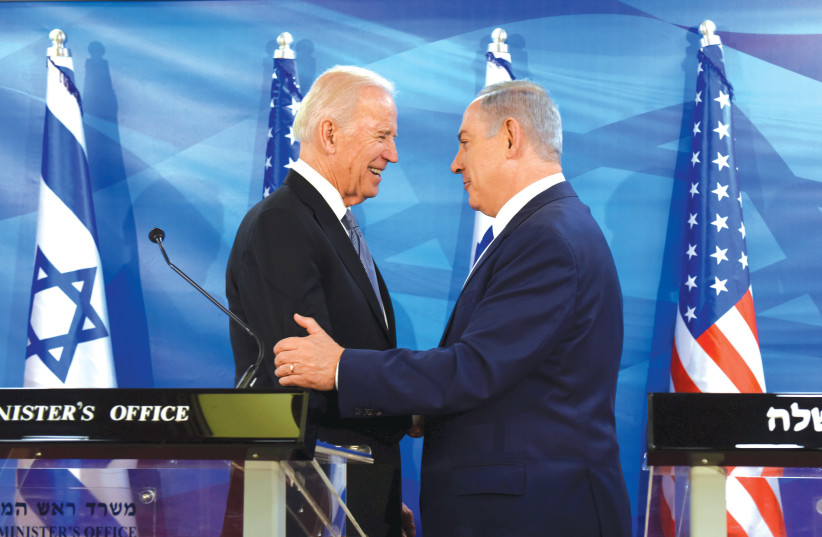While for many Israelis the current time period appears to be the worst possible for reintroducing the idea of the two-state solution, there is undoubtedly an offensive being taken on various levels to promote it. Despite the total failure of the 2005 Disengagement program, which was a post-Oslo collapse attempt at testing the two-state process, the pressure is on again in earnest.
As The Washington Post reported, the Biden administration and a small group of Middle East partners are rushing to complete a comprehensive plan for long-term peace between Israel and Palestinians, “including a firm timeline for the establishment of a Palestinian state that could be announced as early as the next several weeks.”
The State Department’s wisdom is that “the best way to achieve an enduring end to the crisis in Gaza that provides lasting peace and security for Israelis and Palestinians alike, is our strong commitment to the creation of a Palestinian state.”
The American administration is increasingly becoming more forceful. At the Davos gathering in January, US Secretary of State Antony Blinken indicated, as if in an alternate universe, that Israel cannot achieve “genuine security” without a pathway to a Palestinian state. Already back in November, President Joe Biden had said a “real” Palestinian state must come after the war.
Not only would that be surrendering to the Hamas invasion of October 7 and increasing Israel’s insecurity, but it also ignores the fact that Hamas is not that inclined to be part of a deal, but has its sights on replacing the Abbas/PLO regime. If anything, it is working to undermine the reality of the existing two Palestine statelets, one in Gaza and the other in Judea and Samaria, and wants to unite them under its Islamist dictatorship, an outcome the US is ignoring.
It appears that even while criticizing Israel’s government for not developing a “day after” plan, Biden, Blinken and the other two-staters have not sufficiently thought out what “the day after” will be like if an Arab state of Palestine is recognized.
And if they actually have thought their proposal out, the result might very well be to maneuver Israel into a situation where the war against Hamas could be crippled, if not lost. The recently reported move to push for a vote in the United Nations to establish a temporary ceasefire, thus halting ground maneuvers in Rafah, would surely award Hamas a victory – especially if Yahya Sinwar has slipped off to Egypt.
Biden administration not as supportive of Israel
The unavoidable conclusion appears to be that ever since October 7, the Biden administration has not been backing Israel as much as it is trying to salvage the two-state solution bedrock of its diplomacy.
All this diplomacy is being pushed in multiple op-eds that have been published in major newspapers, as if there’s an “Operation Palestine State Flood” drowning the public in its favor.
Some examples: Larry Garber and R. David Harden, both former USAID officials who are linked to the Obama administration, wrote in The New York Times on December 15 that “The US Must Embrace Palestinian Statehood Now.” Tom Friedman’s latest of a plethora of his NYT columns on February 14 was “We Can, and Must, Get a Two-State Solution.” We’re awash with them.
Very few op-eds by Jewish residents of Judea and Samaria have appeared in the Western press – very, very few. The writing of op-eds in favor of a right-wing nationalist Zionist viewpoint is not a formula for passing the opinion editor’s desk at The New York Times, The Washington Post or The Guardian as well as at many other leading media outlets.
Moreover, many of the anti-two-state solution views that do appear in sympathetic outlets lack elements that are important for explaining why such a plan would be not only unsuccessful but dangerous.
While such columns do mention the security danger a Palestinian state would be to Israel, the inability to properly illustrate the matter of topography is a problem. The dominant factor of the Judean and Samaria hill range needs to be stressed: that it overlooks and places all of the coastal plain area in the range of a variety of weapons. To accomplish that correctly, the view from Peduel or Barkan, with Ben-Gurion Airport as well as the Hadera-to-Gedera panoramic, is essential. Words cannot adequately express that threat as well as pictures can.
In the just published March/April issue of Foreign Affairs, Martin Indyk writes on “The Strange Resurrection of the Two-State Solution,” considering it “the only imaginable peace.” Like others, Indyk concentrates on a future solution that conveniently ignores the elements of the past that have caused and stoked the conflict in the first place.
His solution has been attempted since the area of Palestine was first partitioned in 1921 so that a Hashemite Kingdom – Transjordan – could be established. A second partition came in 1937 and the third one in 1947 – all refused by the Arabs. There were other plans suggested that could have led to a state for the Arabs but they turned them all down.
In the meantime, the reality in Judea and Samaria is that Hamas, which also rejects the two-state solution, is the dominant political force for the vast majority of the population supporting the October 7 invasion and massacre.
Not only has the plan not worked in the past, it is an existential security threat to Israel. Moreover, Hamas, the most potent of the political forces representing the Arabs of the former Mandate area, rejects it, while Western grandees of diplomacy repeat its mantra and browbeat Israel.
That is not how allies and friends should act, nor is it a wise path to take.
The writer is a researcher, analyst and opinion commentator on political, cultural, and media issues.

